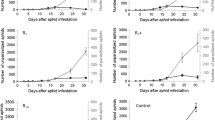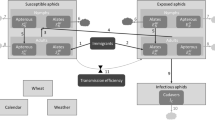Abstract
A particular feature of aphid-parasitoid systems is the existence of a delay between parasitisation (sting) and the death of the host (i.e. mummification). This biological trait is generally not considered important for population stability, except if the delay is very long, and hence it is ignored in most population dynamics studies. However, many crops have relatively short durations, and these time delays may have important consequences and cannot be ignored in a dynamics model. In this study, we are looking for the key-factors that influence an aphidparasitoid system population dynamics during a cropping cycle.
Specifically, a simple model based on ordinary and delay differential equations and including biologically meaningful parameters was developed for aphidparasitoid systems and used to examine: (1) effect of biological characteristics of both the aphid and the parasitoid on their dynamics, (2) the effect of parasitoid augmentation on the dynamics of the system (e.g.: date, number and importance of the releases of parasitoids), and (3) to compare observedAphis gossypii — Lysiphlebus testaceipes dynamics in a cucumber crop to the predictions of the model.
Good fits between the model and the field data were obtained and suggest that this model may be a powerful tool for selecting species of parasitoid and strategies for their use in biological control augmentation programs for aphid pest management.
Résumé
Une particularité des systèmes hôte-parasitoïde est l’existence d’un retard entre la piqûre parasitaire et la mort de l’hôte (i.e. momification pour les pucerons). Cet aspect n’est généralement pas considéré comme décisif pour la stabilité des populations, sauf si le retard est très long, et, de ce fait, généralement ignoré dans la plupart des études de dynamique de populations. Cependant, la plupart des cultures ont une durée relativement courte, et ce retard peut avoir des conséquences importantes et ne peut être ignoré dans un modèle de dynamique. Dans cette étude, nous recherchons les facteurs clé qui agissent sur la dynamique des populations d’un système puceron-parasitoide pendant la durée d’une culture.
Pour cela, un modèle simple basé sur des équations différentielles à retard, incluant des paramètres biologiques, est établi pour représenter le système puceron-parasitoïde et utilisé: (1) pour examiner l’effet des caractéristiques biologiques du puceron et du parasitoïde, (2) pour examiner celui de différentes stratégies de lâcher de parasitoïdes sur la dynamique des populations, et (3) pour comparer la dynamique du coupleAphis gossypii — Lysiphlebus testaceipes en serre de concombre avec les prédictions du modèle.
Le bon ajustement du modèle aux données de terrain suggère que le modèle peut être un outil puissant pour choisir des espèces de parasitoïdes et définir des stratégies de lâcher d’auxiliaires pour les programmes de lutte biologique contre les pucerons.
Similar content being viewed by others
References
Abell, M. L. &Braselton, J. P. — 1993. Differential equations with Mathematica. —Academic Press, London. 631 pp.
Barlow, N. D. &Dixon, A. F. G. — 1980. Simulation of lime aphid population dynamics. —Pudoc, Wageningen. 165 pp.
Dixon, A. F. G. — 1987. Parthenogenetic reproduction and the rate of increase in aphids.In: Aphids, (Minks & Harrewijn, eds), vol. 2A. —Elsevier, 269–289.
Gilbert, N. &Gutierrez, A. P. — 1973. A plant-aphid-parasite relationship. —J. Anim. Ecol., 42, 323–340.
Gilbert, N., Gutierrez, A. P., Frazer, B. D. & Jones, R. E. — 1976. Ecological relationships. —W. H. Freeman & Co. 157 pp.
Holling, C. S. — 1966. The functional response of invertebrate predators to prey density. —Mem. Entomol. Soc. Can., 48, 3–86.
Hughes, R. D., Woolcock, L. T. &Hughes, M. A. — 1992. Laboratory evaluation of parasitic hymenoptera used in attempts to biologically control aphid pests of crops in Australia. —Entomol. exp. appl., 63, 177–185.
Kindlmann, P. &Dixon, A. F. G. — 1993. Optimal foraging in ladybird beetles (Coleoptera: Coccinellidae) and its consequences for their use in biological control. —Eur. J. Entomol., 90, 443–450.
Kindlmann, P. & Dixon, A. F. G. — 1997. Strategies of aphidophagous predators: lessons for modelling insect predator-prey dynamics. —BioControl, this issue.
Lapchin, L., Boll, R., Rochat, J., Geria, A. M. & Franco, E. — 1997. Using projection pursuit nonparametric regression in modelling insect densities from visual abundance classes. —Environ. Entomol., in press.
May, R. M. &Hassell, M.P. — 1988. Population dynamics and biological control. —Phil. Trans. R. Soc. Lond.,B 318: 129–169.
Murdoch, W. W. — 1990. The relevance of pest-enemy models to biological control. —Critical Issues in Biological Control. (MacKauer, Ehler & Roland, eds), Intercept., 1–24.
Murray, J. D. — 1993. Mathematical Biology, 2nd Ed.,Springer-Verlag, 767 pp.
Nisbet, R. M. &Gurney, W. S. C. — 1982. Modeling fluctuating populations. —J. Wiley & Sons, London. 379 pp.
Renshaw, E. — 1991. Modelling biological populations in space and time. —Cambridge University Press, 403 pp.
Van Lenteren, J. C. &Woets, J. — 1988. Biological and integrated pest control in greenhouses. —Ann. Rev. Entomol., 33, 239–269.
Van Steenis, M. — 1993. Intrinsic rate of increase ofAphidius colemani Vier. (Hym., Braconidae), a parasitoid ofAphis gossypii Glov. (Hom., Aphididae), at different temperatures. —J. Appl. Ent., 116, 192–198.
Van Steenis, M. — 1994. Intrinsic rate of increase ofLysiphlebus testaceipes Cresson (Hymenoptera: Braconidae), a parasitoid ofAphis gossypii Glover (Homoptera: Aphididae), at different temperatures. —J. Appl. Ent., 118, 399–406.
Van Steenis, M. J. — 1995. Evaluation of four aphidiine parasitoids for biological control ofAphis gossypii. —Entomol. exp. appl., 75, 151–157.
Wolfram Research, Inc. — 1992. Mathematica 2.2. User’s guide. —Wolfram Research, Inc., Champaign, Illinois. 961 pp.
Author information
Authors and Affiliations
Rights and permissions
About this article
Cite this article
Rochat, J. Delayed effects in aphid-parasitoid systems: Consequences for evaluating biological control species and their use in augmentation strategies. BioControl 42, 201–213 (1997). https://doi.org/10.1007/BF02769898
Published:
Issue Date:
DOI: https://doi.org/10.1007/BF02769898




